You can make a delicious emergency beef stew without electricity using alternative cooking methods like a solar cooker, portable stove, or camping cooker. Start with uniformly cut chunks of beef chuck roast and bite-sized vegetables like Yukon Gold potatoes, carrots, and onions. Place your ingredients in a dark-colored pot for maximum heat absorption, and cook on low heat for 6-8 hours or high heat for 4 hours until the meat becomes tender. During power outages, maintain food safety by keeping perishables cold and monitoring temperatures carefully. With the right tools and techniques, you'll discover how to create hearty, nutritious meals regardless of grid access.
Why Cook Without Power

Why explore cooking methods that don't require electricity? In today's uncertain world, knowing how to prepare meals without power isn't just a useful skill – it's essential for your self-sufficiency and survival.
You'll develop independence from the grid while deepening your connection with traditional cooking methods and nature itself. Learning to use proper storage techniques will ensure your ingredients stay fresh and safe for extended periods.
When emergencies strike, you'll be ready to maintain proper nutrition without relying on modern appliances. Whether you're facing a power outage or natural disaster, you'll have the knowledge to keep your family fed.
You'll also contribute to environmental conservation by using eco-friendly methods like solar ovens and wood-burning stoves, reducing your carbon footprint.
Plus, you'll gain flexibility to cook anywhere, from your backyard to remote locations, using various techniques that can enhance your food's flavor and texture.
Essential Kitchen Tools
Four core categories of kitchen tools are essential for powerless cooking: cooking equipment, utensils, fire-starting gear, and miscellaneous tools.
You'll need a reliable heat source like a portable stove or solar cooker, plus water purification methods to guarantee safe drinking and cooking water.
Natural disasters are becoming more common, making proper emergency preparation increasingly critical.
For your emergency cooking setup, make certain you have:
- A durable stainless steel pot and cast iron skillet
- Multi-purpose utensils including a spork or cutlery set
- Multiple fire starters and fuel tablets
- A manual can opener and basic cleaning supplies
- A potato peeler and meat tenderizer
Keep your tools organized and accessible.
Stainless steel and cast iron cookware are ideal since they're virtually indestructible and can withstand direct heat from various fuel sources.
Don't forget cleaning supplies to maintain hygiene during emergency cooking situations.
Preparing Your Solar Cooking Station
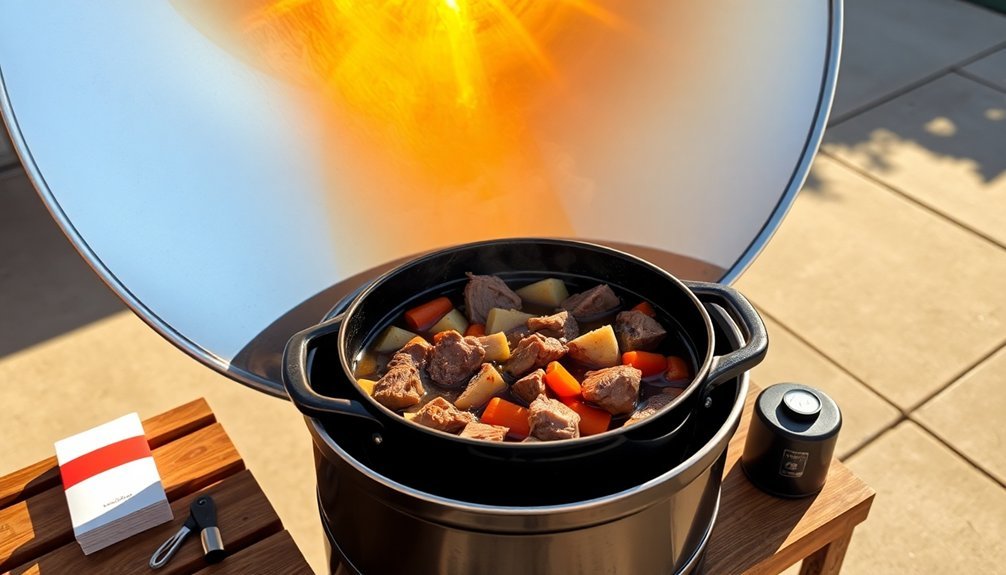
Before you start cooking your beef stew, you'll need to set up your solar cooker in a sunny spot with unobstructed sunlight, ideally between 10 AM and 2 PM when solar energy is strongest.
Position your cooker on a stable, level surface and preheat it while you're preparing your ingredients, ensuring all insulation components are properly secured. Use a dark-colored pot to maximize heat absorption and ensure efficient cooking.
Adjust your reflector panels to focus maximum sunlight onto your dark cooking pot, angling them to track the sun's movement throughout the cooking process.
Location and Sun Exposure
Setting up your solar cooking station properly is crucial for successfully preparing beef stew. You'll need to choose a dry, level area with direct sunlight and protection from wind. Position your cooker where it'll receive continuous sun exposure throughout the cooking period, avoiding shadows from trees or buildings.
- Orient the cooker so the sun's shadow falls directly behind it.
- Face the cooker where the sun will be mid-afternoon if planning an evening meal.
- Rotate the cooker 30 degrees clockwise to enhance sun exposure.
- Adjust the reflective flap higher for high sun positions, lower for low sun positions.
- Add stones or bricks for stability on windy days.
Remember to reposition your cooker every couple of hours to maintain ideal sun exposure.
While constant supervision isn't necessary, periodic adjustments will guarantee your beef stew cooks evenly and efficiently.
Equipment Setup Guide
A well-prepared solar cooking station makes all the difference in creating a perfect beef stew. Start by choosing a dark-colored pot, preferably cast iron or graniteware painted black on the outside.
You'll need an elevated wire mesh stand to raise your pot about 6 centimeters off the base, allowing sunlight to reflect underneath.
Set up your solar oven by lining it with black construction paper and adding crumpled newspapers for insulation. Cover the inner flap with smooth aluminum foil, shiny side out, and create a clear plastic window to trap heat.
If you're using a bucket cooker, insert a shiny car window shade as a cone reflector. Place heavy rocks around the base for stability on windy days.
Don't forget to preheat your solar oven while preparing ingredients.
Reflector Panel Positioning
Proper positioning of your reflector panels directly impacts your solar cooker's performance and cooking time. For your beef stew, you'll need to adjust the panels throughout the day to maintain ideal heat reflection. When the sun's directly overhead, position your reflectors at a 30-degree outward angle from the box.
- At 9 AM or 3 PM, set your sunward reflector 30 degrees above horizontal, with the opposite reflector vertical.
- For evening cooking, face the shorter front panel westward for mid-afternoon sun exposure.
- Rotate reflectors 10 degrees per hour to track the sun's movement.
- Position the front flap higher during peak sun hours and lower when the sun's near the horizon.
- During sunrise or sunset, keep the sunward reflector horizontal, with the opposite panel leaning 30 degrees over the box.
Meat and Vegetable Selection
To make an exceptional beef stew, you'll want to choose beef chuck roast for its rich marbling and ability to become tender during slow cooking.
When selecting your vegetables, stick to waxy potatoes like Yukon Gold or red potatoes that hold their shape, and cut your carrots, celery, and onions into uniform pieces for even cooking.
Don't forget to trim excess fat and silver skin from your meat before cutting it into similar-sized chunks, which guarantees everything cooks consistently.
Choosing Quality Beef Cuts
Selecting the right cut of beef stands as the foundation of a delicious slow-cooked stew. Chuck steak emerges as an ideal choice, thanks to its rich marbling and abundant connective tissue that transforms into gelatin during cooking.
If you can't find chuck steak, short ribs offer a flavorful alternative that becomes tender after extended cooking.
For the best results with your chosen cut:
- Trim excess fat and silvery connective tissue to prevent greasiness
- Cut meat into uniform pieces to guarantee even cooking
- Choose grass-fed beef when possible for better nutrition
- Look for meat with visible marbling throughout
- Avoid lean cuts that can become tough and dry
Remember to reflect on how the meat's connective tissue will break down during cooking, as this directly impacts your stew's final texture and flavor.
Best Stew Vegetables
A well-balanced stew depends just as much on its vegetables as its meat.
You'll want to start with a classic mirepoix base of chopped onions, celery, and minced garlic. Add root vegetables like carrots, potatoes, and rutabaga, which provide natural sweetness and hearty texture.
Don't peel the potatoes – their skins add extra nutrients and better texture.
For deeper flavor, include quartered mushrooms and aromatic herbs like thyme, oregano, and a bay leaf. You can enhance the stew's richness with tomato paste and a splash of red wine or Worcestershire sauce.
Save tender vegetables like green beans and peas for the final 30 minutes of cooking to prevent them from becoming mushy.
For extra flavor, consider using celery leaves or carrot tops in your stock.
Step-By-Step Cooking Process

Whether you're using a slow cooker or stovetop, creating a delicious beef stew starts with proper preparation. Begin by cutting your beef into uniform chunks and chopping your vegetables into bite-sized pieces.
You'll want to brown the meat first to enhance its flavor, though this step is optional if you're short on time.
- Combine your browned meat, vegetables, and broth in your cooking vessel
- Add your chosen herbs and seasonings, stirring well to distribute
- Cover and cook on low heat for 6-8 hours or high for 4 hours
- Check periodically for meat tenderness and vegetable doneness
- Thicken with cornstarch mixture if desired, and adjust seasonings
Remember to add delicate vegetables like green beans toward the end of cooking to prevent them from becoming mushy.
Once everything's tender and the broth has reached your preferred consistency, you're ready to serve.
Alternative Heat Sources
While traditional stovetops and slow cookers offer reliable cooking methods, unexpected power outages or outdoor adventures may require you to explore backup options for preparing your beef stew.
Your best option is a portable butane stove, which you can safely use indoors and generates enough heat for a complete cooking process. You'll find these compact stoves convenient, and their butane canisters provide substantial cooking time.
If you're cooking outdoors, consider using a propane grill or camping cooker. Just make sure you've got spare propane containers stored properly outside.
For indoor emergencies, you can use catalytic heaters with proper ventilation, though they're less ideal than butane stoves.
Storage During Power Outages
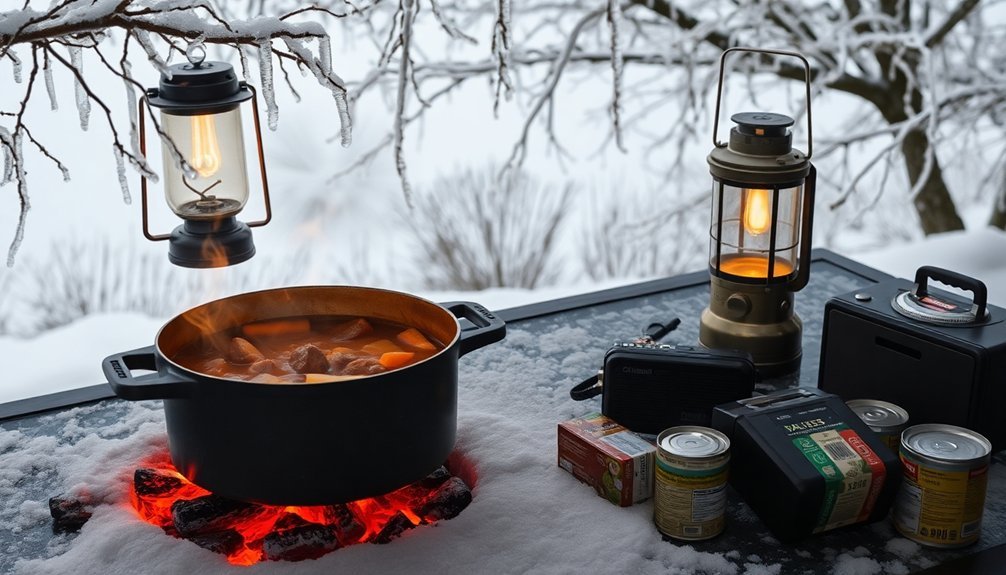
During power outages, proper food storage becomes critical to prevent your beef stew and other perishables from spoiling. Keep your refrigerator and freezer doors closed as much as possible to maintain cold temperatures. Your fridge should stay at 40°F (4°C) or below, while your freezer needs to remain at 0°F (-18°C) or lower.
Before the power goes out, you'll want to:
- Freeze water containers and ice packs to help maintain lower temperatures
- Group refrigerated and frozen foods together for better temperature retention
- Keep a cooler ready with ice for transferring perishables if needed
- Monitor how long the power's been out – food's safe for 4 hours in the fridge
- Transfer food to a cooler with ice if the outage extends beyond 4 hours
Frequently Asked Questions
How Long Can the Stew Safely Stay in a Thermal Cooker?
You can safely keep your stew in a thermal cooker for up to 8 hours as long as it maintains temperatures above 140°F. If it drops below this temperature, you'll need to reboil it.
Can I Add Frozen Vegetables Directly to the Stew?
Yes, you can add frozen vegetables directly to your stew without thawing them first. It's actually safer this way, as it prevents bacterial growth. They'll cook evenly and retain their nutrients while simmering.
What's the Minimum Temperature Needed for Safe Slow Cooking?
You'll need to maintain at least 165°F (73.9°C) throughout the slow cooking process to guarantee food safety. Your cooker should reach this on both low and high settings after proper preheating time.
How Do I Prevent Vegetables From Becoming Too Mushy?
You'll prevent mushy vegetables by cutting them into large chunks, adding firmer veggies like roots first, and introducing delicate ones in the final 30-45 minutes. Choose hardy vegetables and don't overcrowd your pot.
Should I Adjust Liquid Amounts When Cooking at High Altitudes?
Yes, you'll need to increase liquids at high altitudes due to faster evaporation. Add 1-2 tablespoons extra at 3,000 feet, plus 1½ teaspoons more for each additional 1,000 feet of elevation.
In Summary
You've now learned how to create a hearty beef stew without relying on electricity. Whether you're using solar power, a rocket stove, or other alternative cooking methods, you'll have a reliable way to feed your family during emergencies. Keep these techniques in mind, maintain your emergency cooking supplies, and you'll be ready to provide nourishing meals even when the power's out. Practice these methods before you need them.

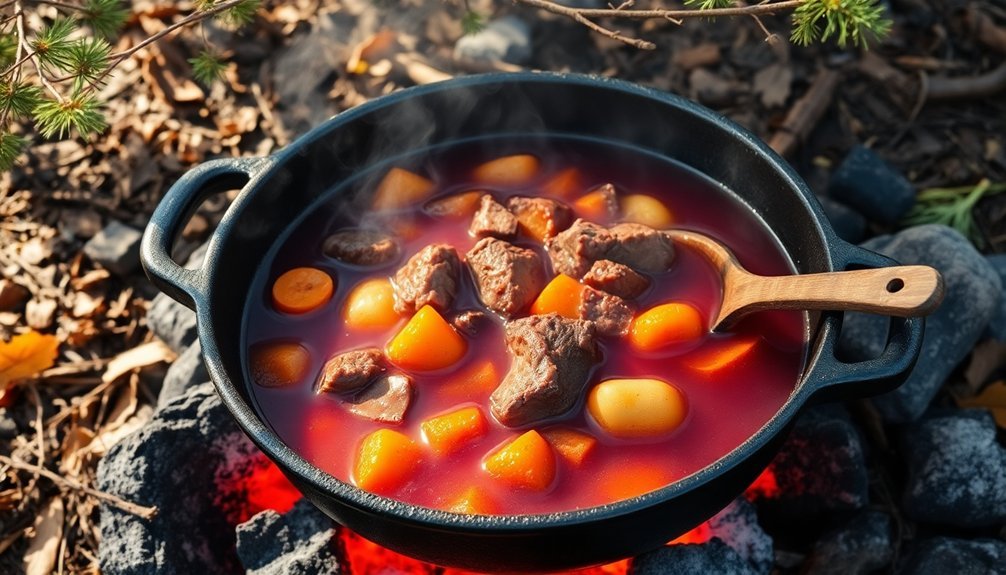
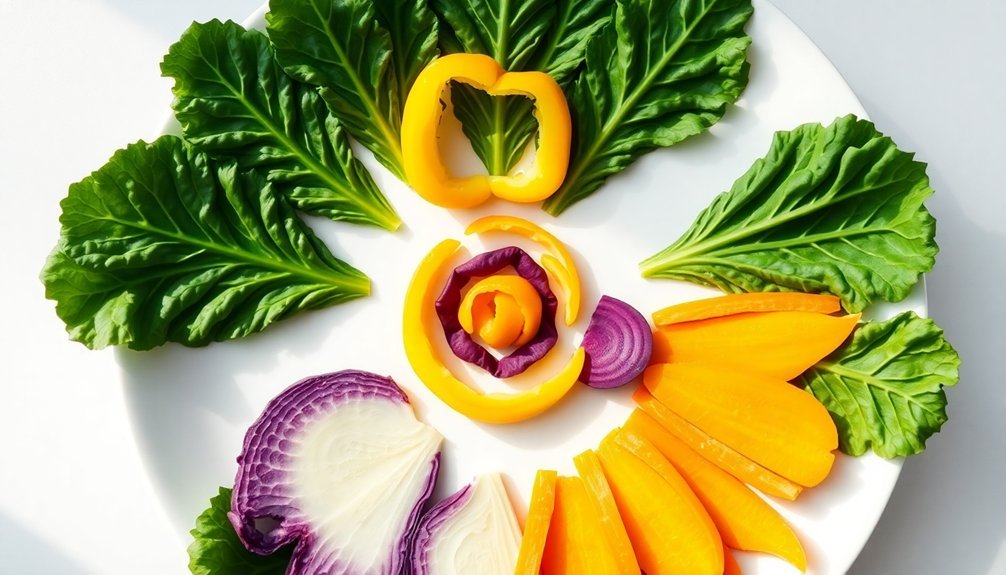

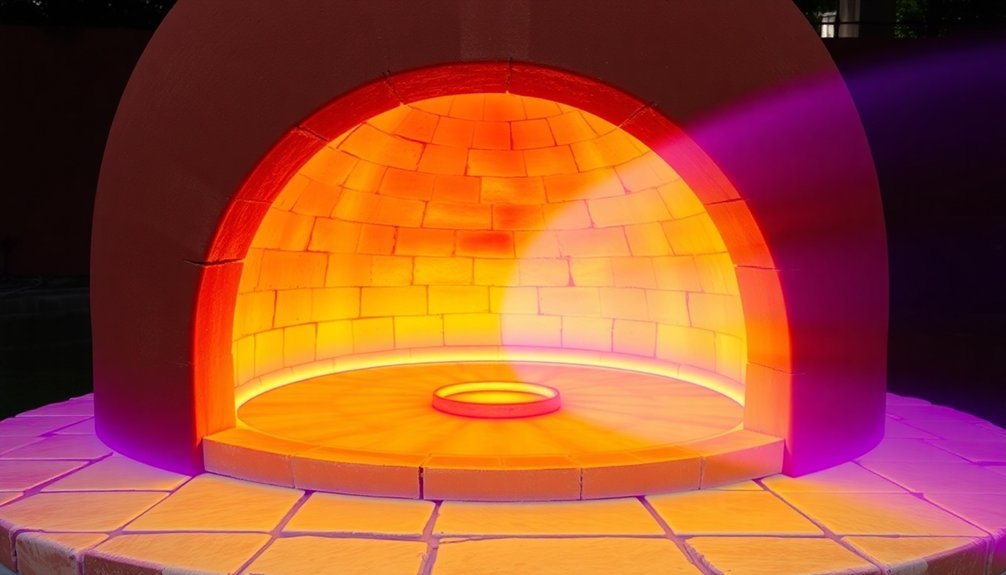
Leave a Reply